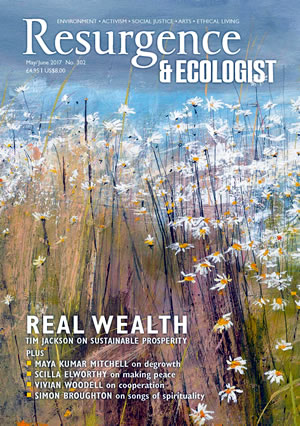Why war continues
Until now it has been normal to consider military might as the determinant of an international pecking order. Possession of the weapons and the forces to deter or frighten other nations has even determined the structure of the United Nations, giving the power of veto to the five permanent members of the Security Council, who also happen to be among the world’s biggest arms sellers as well as the first possessors of nuclear weapons.
War makes a relatively few people extremely rich. Global military expenditure in 2015 was an estimated US$1.67 trillion, equal to US$217 for each person in the world. The total value of the global arms trade in 2014 was at least US$94.5 billion. By contrast, US$24 billion per year would ensure clean water and safe sanitation for everyone on the planet.
Those who thrive in war are also people traffickers, arms smugglers, money launderers, drug dealers and others who require a lawless environment to make a fortune.
Stopping war, because it is such an unfamiliar concept to us, requires a substantial shift in assumptions. Traditionally it has been assumed that weaponry and “defence” will bring security, and therefore that more weaponry will bring more security.
How peace can be built
Humanity has now entered a new era where these assumptions require an overhaul. The major threats to our security now emanate from issues that cannot be dealt with by weaponry, namely global warming, migration, cyber attack and the rich–poor gap.
Our security now depends on our ability to cooperate with nations who might previously have been our enemies. We now know enough about preventing armed violence to avoid the catastrophic consequences of recent wars. The overall strategy in my latest book, The Business Plan for Peace: Making a World Without War Possible, is to develop a whole-systems approach to building peace worldwide, from the local level to national, regional and global levels. The three basic principles include dialogue, prevention, and valuing women.
Dialogue
Attempts to stop war from the top down often fail because of the mindsets – fear, aggression, competition, greed – shared by most of those leaders filtered to the top by our current systems. One of the best ways to overcome the force of these attitudes and emotions is by systematically building trust through dialogue.
The Oxford Process is a tried and tested programme developed by Oxford Research Group over three decades, facilitating high-level dialogue between those involved in some of the world’s most intractable conflicts. It uses the tools of analysis, cultural savvy and human psychology to understand and manage both the tensions and the human relationships that underpin conflict.
These same tools can be learned and applied by any of us to transform conflicts in the family, in the community, or further afield.
Prevention
The keys to successful prevention of war are respect, speed of reaction, and developing an understanding of how power works. All the research I have seen over 35 years shows that the main cause of fighting is humiliation: interviews with death row inmates revealed that this was the most common motivation for homicide. The best antidote to humiliation is respect. It’s hard to find something to respect in those you may hate or despise, but they too are human and have qualities you can unearth and salute. It works: it produces the possibility of dialogue.
Your speed of reaction requires practice. This can be acquired through meditation, martial arts, and all practices that train you in self-awareness. The more self-knowledge you have, the more effective you will be in preventing violence – whether verbal or physical.
Locally led peace-building initiatives excel in the skills of prevention. The organisation Peace Direct was set up to support grass-roots peace builders, because local people tend to know best how to resolve local conflicts. Peace Direct’s research in turn resulted in Insight on Conflict, an online initiative that currently reports on over 1,400 peace-building organisations across 44 different conflict-affected regions.
Breaking the cycle of violence
The cycle of violence starts with an atrocity, causing terror and trauma, followed by grief and then anger, which leads to the drive for retaliation and revenge, causing an escalation of atrocities. Thus the cycle of violence can continue over generations and even centuries.
The cycle can be broken by tried and tested methods of conflict transformation, including consultation with religious leaders, bridge building, setting up truth and reconciliation commissions, training mediators, freeing child soldiers, trauma counselling and strengthening the rule of law.
At national level, governments can establish an infrastructure for peace, a process pioneered in South Africa by Nelson Mandela, developing peace councils at national, regional, city, town and even village levels through which respected community leaders can be trained in violence-prevention methods and developing a peace plan for their area should violence break out. This has already been copied in Ghana and Kenya.
Enable women to help make peace
Women are shown to be the most effective and tenacious peace builders. However, more than 90% of negotiators and those in policymaking positions on peace and conflict are male, meaning that the suffering and trauma of women and children in war are not taken into account at the peace table.
Swanee Hunt, a former US ambassador to Austria, and the Women Waging Peace Policy Commission have conducted 15 field-based case studies to document women’s contributions to conflict prevention, peace negotiations and post-war reconstruction. This has now yielded a network of over 1,000 trained women leaders from more than 30 conflicts, and strategies to ensure their acceptance in policymaking positions and peace negotiations.
What it will cost
To my knowledge no one has so far attempted to cost the strategies necessary to build a world without war. So in my book I have laid out a first blueprint for a business plan for peace – based on 20 years developing dialogue between nuclear weapons decision-makers and their informed critics, as well as 15 years supporting locally led peace-building initiatives. This plan describes and costs the following:
Four systems for preventing conflict and building peace at local level, at a total cost of US$159 million;
Nine systems for preventing conflict and building peace at national/regional level, at a total cost of US$664 million; and
Twelve systems for preventing conflict and building peace at international level, at a total cost of US$1,178 million.
The total cost of local, national and international systems for preventing conflict over a 10-year period comes to just over US$2 billion. By comparison, in a year we spend US$59 billion on ice cream, Procter & Gamble spent US$9.3 billion on advertising in 2012, and the decommissioning costs of the Fukushima reactors will top US$105 billion.
Who can do it?
The key strategy is to do the personal work – the inner development – that is essential if people are to be effective in their efforts to make the world a safer place. This is for a specific reason: when we have strong emotions like fear or anger, if we’re not awake to what’s going on inside us we tend to project those emotions onto others.
This projection, on a larger scale, is what causes wars. Leaders become excessively incensed with the aggressivity of the other side when they have not examined and dealt with their own internal anger. This demonisation of the other permits all kinds of horror.
If we are to work effectively in conflict, whether in government or at the grass roots, we need to understand this kind of projection on a personal level. To do this can be uncomfortable and can require real courage, because we are confronting our own deeply embedded convictions and emotions. But when we really get it – that is, really get what a hugely powerful force it can be – we become ten times more effective.
What becomes evident in this work is that we are living through an age of profound transformation in the human condition. The human-made issues we face in this turbulent age are challenging our human capacity to evolve. We have the opportunity now, as never before, to develop our consciousness – and therefore our way of treating one another – to a new level.







